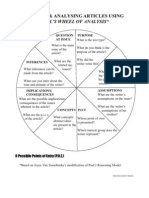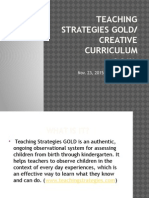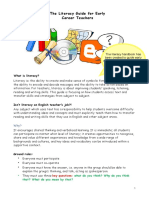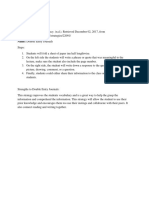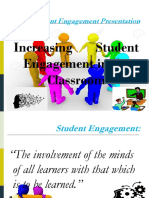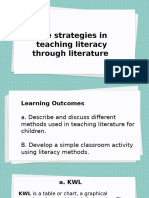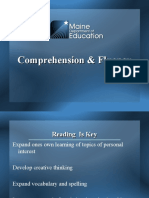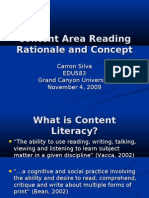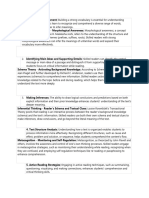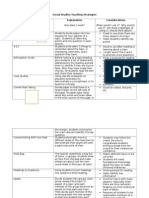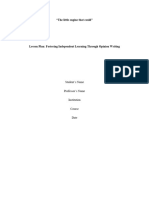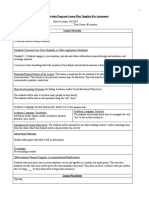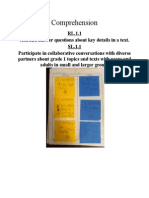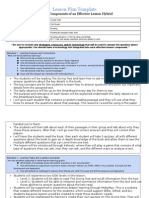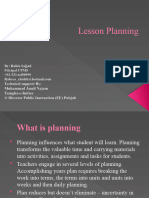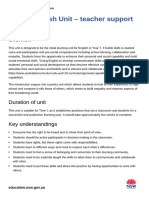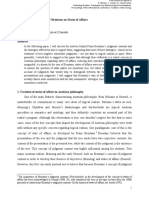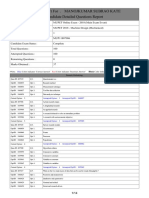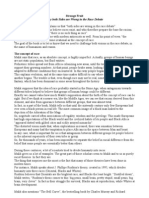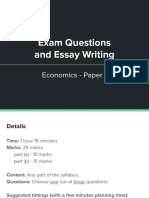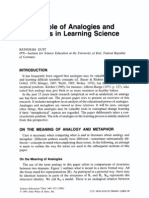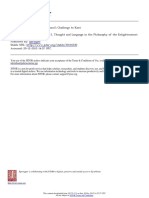Semantic Mapping Uni
Semantic Mapping Uni
Uploaded by
Natalia SerranoCopyright:
Available Formats
Semantic Mapping Uni
Semantic Mapping Uni
Uploaded by
Natalia SerranoOriginal Title
Copyright
Available Formats
Share this document
Did you find this document useful?
Is this content inappropriate?
Copyright:
Available Formats
Semantic Mapping Uni
Semantic Mapping Uni
Uploaded by
Natalia SerranoCopyright:
Available Formats
NSW Centre for Effective Reading
Middle Years
Vocabulary- Semantic Mapping
Introduction
Semantic mapping is a strategy for graphically representing concepts. A semantic word map allows students
to conceptually explore their knowledge of a new word by mapping it with other related words or phrases
similar in meaning to the new word.
There are three components to a semantic map:
1. Core question or concept: this is a key word or phrase that is the main focus of the map.
2. Strands: subordinate ideas that help explain or clarify the main concept. These can be generated by the
students.
3. Supporting information: details, inferences and generalization that are related to each strand. Supports
clarify the strands and distinguish one strand from another.
The following teaching steps are adapted from Denton, C. Bryan, D. Wexler, J., Reed, D. & Vaughn, S. (2007)
Effective Instruction for Middle School Students with Reading Difficulties: The Reading Teacher’s Sourcebook.
University of Texas.
NSW Centre For Effective Reading Vocabulary| Semantic Mapping
Page 1
Purpose
The students will associate new word meaning with prior knowledge through the use of a semantic map.
Materials
• Topic or text
• Overhead projector, chalkboard, chart paper or Interactive White Board (IWB).
Preparation
Preview the text, looking for content words, or challenging words that students are likely to see and use often
in academic settings. Prioritise the words students must know in order to understand the topic or text (See
Vocabulary – Which words do I teach?).
Teaching steps
1. State objective/purpose
State the purpose of the lesson.
Today we are going to make a semantic map. Information is stored in your brain in categories or groups.
Words in your memory are linked to other words based on their relationships. So, if you can connect a new
word with a word you already know, you will be better able to remember the new word. I’m going to show you
how to go through this process today by developing a semantic map.
Introduce the text/topic.
Write the topic/concept on the board (or overhead/IWB).
2. Model and teach with the whole class
• Ask students to brainstorm or think of words related to the topic/concept. Think pair share can be used
to support brainstorming (see Appendix 2).
List all of the words on one-half of the board (or overhead). Write down all appropriate student
responses.
Ask questions to lead students to identify words related the topic/concept.
Any unfamiliar words give a brief definition for each.
• Draw a circle with the topic in the middle.
• Read through the list of brainstormed words and model using Think Aloud how to identify categories to
group the words.
• Ask students to identify further with categories. Write each category or strand in a circle and connect it
to the topic.
NSW Centre For Effective Reading Vocabulary| Semantic Mapping
Page 2
If students have difficulty generating categories, you may need to think aloud and model how to come up with
categories several times.
• Identify any supporting information for each category or strand.
3. Guided practice with partners
• Assign partners and give pairs a copy of the semantic map. Ask pairs to generate any remaining
category or strand titles and to categorise the brainstormed words.
• Ask students to come up with additional words for each category and any supporting information.
• Circulate around the room and be available for guidance and feedback. Check each pair of students to
check for understanding. Be prepared to model again if needed.
• Ask pairs to add a blank category to their semantic map to fill in after they read the text. As you
circulate around the classroom, ask leading questions to guide student responses.
• Return to the map on the board and whole-class grouping.
• Ask for student responses to each category and write appropriate responses on a master semantic
map. Allow students to add words to their semantic maps based on class discussion and the master
semantic map.
• Read the selected text or have students read the text in pairs. Remind students to be aware of target
words in the reading and to look for other categories they might want to add to their semantic maps.
• When the class is finished reading the selection, return to the master semantic map on the board (or
overhead/IWB). Discuss the concepts included in the reading. Add new concepts learned during
reading to the semantic map.
• Ask students whether they discovered any other categories, or groups of things with common
characteristics, in the reading. If needed, think aloud for the class.
• Have students work with partners to fill in examples under each new category. When students are
finished, ask for responses and discuss.
4. Independent Practice
• Before reading a passage or selection, preview the text for challenging words students will use and see
often (see procedure at the beginning of this lesson).
• Tell students the topic of the reading passage or selection and lead students to brainstorm a list of
words related to the topic. Discuss background knowledge of the topic and help students make
connections between what they already know and what they will learn while reading.
• Working in small groups or partners, ask students to create a semantic map by categorising the
brainstormed list of words. This includes generating logical category titles and placing words in
appropriate categories.
• As students read have them add new vocabulary words to their maps. Discuss with students the
meaning of the new words and where they fit on the map.
• After students read the passage have them add any other vocabulary words to the map. Return to
whole group and discuss students’ semantic maps. Discuss with the students how the semantic map
might be expanded or reorganised to reflect new information they learned
5. Generalisation
Identify situations in Key Learning Areas where students could use semantic maps to assist their
understanding of the vocabulary in a topic/concept.
NSW Centre For Effective Reading Vocabulary| Semantic Mapping
Page 3
Technology Tip
Mind mapping tools could be used to represent the semantic map used in this strategy.
Below are examples of some free mind mapping tools:
XMind: http://www.xmind.net
Freemind http://freemind.sourceforge.net/wiki/index.php/Main_Page
References
Denton, C. Bryan, D. Wexler, J., Reed, D. & Vaughn, S. (2007) Effective Instruction for Middle School
Students with Reading Difficulties: The Reading Teacher’s Sourcebook. University of Texas.
Rosenbaum, C. (2001). A word map for middle school: A tool for effective vocabulary instruction Journal of
Adolescent & Adult literacy. September 45:1, 44-49.
Semantic Mapping (n.d.). Retrieved December 22, 2011, from
http://literacy.kent.edu/eureka/strategies/semantic_mapping.pdf
NSW Centre For Effective Reading Vocabulary| Semantic Mapping
Page 4
Appendix 1 - Semantic Map Examples
NSW Centre For Effective Reading Vocabulary| Semantic Mapping
Page 5
Appendix 2 – Think Pair Share
Think-Pair-Share
Overview
Think-Pair-Share is a cooperative learning strategy that can promote and support higher-level thinking. The
teacher asks students to think about a specific topic, and then pair with another student to discuss their
thinking and, after that, share their ideas with the group.
Steps
1. Decide on how to organise students into pairs.
2. Pose a discussion topic or a question.
3. Give students at least 10 seconds to think on their own ("think time").
4. Ask students to pair with their partner and share their thinking.
5. Call on a few students to share their ideas with the rest of the class.
What teachers do What students do
Before • Read the chapter or section, if the Think/Pair/Share
• Have students read a selection or prepare a topic, is based on information and ideas from a reading
question, or prompt for a planned Think/Pair/Share selection.
activity.
OR
• Choose a “teachable moment” during the class
where the process of reflection and
shared discussion would bring deeper
understanding, and insert a brief Think/
Pair/Share activity into the lesson at that point.
In either case:
• Consider the social and academic goals for the
Think/Pair/Share activity, and plan for pairing of
particular learners that would further those goals.
During • Formulate thoughts and ideas, writing them down as
• Ask students to spend several minutes thinking necessary to prepare for sharing with a partner.
about and writing down ideas. • Practise good active listening skills when working in
• Set clear expectations regarding the focus of pairs, using techniques such as paraphrasing what
thinking and sharing to be done. the other has said, asking for clarification and orally
• Put students in pairs to share and clarify their ideas clarifying their own ideas.
and understanding.
• Monitor students’ dialogue by circulating and
listening.
After • Pinpoint any information that is still unclear after the
• Call upon some pairs to share their learning and pair discussion, and ask the class and teacher for
ideas with the whole class. clarification.
• Possibly extend the Think/Pair/Share with a further
partner trade, where students swap
partners and exchange ideas again.
• Consider adding a writing activity as a productive
follow-up to a Think/Pair/Share activity.
Think Literacy: Cross-Curricular Approaches, Grades 7-12, 2003
http://www.lkdsb.net/program/elementary/intermediate/di/files/22Strategies(Think%20Pair%20Share).pdf
NSW Centre For Effective Reading Vocabulary| Semantic Mapping
Page 6
Hints and Management Ideas
• Pre-assign partners. Rather than waiting until the discussion time, indicate in advance who students' partners
will be. Otherwise, the focus might be on finding a partner rather than on thinking about the topic at hand.
• Change partners. Students should be given an opportunity to think with a variety of partners.
• Monitor the discussions for common misconceptions and unique ideas to address later with the whole group.
Further Support
Some students may benefit from a discussion with the teacher to articulate their ideas before moving on to
share with a partner.
Benefits of Think-Pair-Share
• When students have appropriate “think time”, the quality of their responses improves.
• Students are actively engaged in thinking.
• Thinking becomes more focused when it is discussed with a partner.
• More critical thinking is retained after a lesson in which students have had an opportunity to discuss and
reflect on the topic.
• Many students find it easier or safer to enter into a discussion with another classmate, rather than with a
large group.
• No specific materials are needed for this strategy, so it can be easily incorporated into lessons.
• Building on the ideas of others is an important skill for students to learn.
adapted from Online Teaching Resource Think-Pair-Share (n.d.). Retrieved February 2, 2012, from
http://www.eworkshop.on.ca/edu/pdf/Mod36_coop_think-pair-share.pdf
NSW Centre For Effective Reading Vocabulary| Semantic Mapping
Page 7
You might also like
- 2 Learning TheoriesDocument10 pages2 Learning TheoriesAJAY KUMAR BEHERANo ratings yet
- Nature, Design and ScienceDocument231 pagesNature, Design and ScienceBrian Ngenoh100% (1)
- Paul's Wheel of ReasoningDocument2 pagesPaul's Wheel of ReasoningJia LiNo ratings yet
- Teaching Strategies Gold - Slide ShowDocument16 pagesTeaching Strategies Gold - Slide Showapi-301357311No ratings yet
- Literacy HandbookDocument16 pagesLiteracy Handbookapi-299191866No ratings yet
- Preparing To ReadDocument2 pagesPreparing To Readapi-532433665No ratings yet
- Literacy HandbookDocument16 pagesLiteracy Handbookapi-299191866No ratings yet
- Examples of Differentiated Instruction StrategiesDocument3 pagesExamples of Differentiated Instruction StrategiesvdesperceNo ratings yet
- Read Aloud StrategyDocument2 pagesRead Aloud Strategyapi-248208787No ratings yet
- Strategy Notebook Explanation2Document20 pagesStrategy Notebook Explanation2api-396110984No ratings yet
- Teaching Reading Theory 20 Copies PDFDocument7 pagesTeaching Reading Theory 20 Copies PDFDN MukhiyaNo ratings yet
- How Do You Effectively Engage Your Students in LearningDocument22 pagesHow Do You Effectively Engage Your Students in LearningKim B. AlcanceNo ratings yet
- Lesson Planning Form For Accessible Instruction - Calvin College Education ProgramDocument4 pagesLesson Planning Form For Accessible Instruction - Calvin College Education Programapi-339549780No ratings yet
- EnglishDocument41 pagesEnglishpatinofehbbygeanNo ratings yet
- Interactive Read AloudsDocument2 pagesInteractive Read Aloudsapi-263426795No ratings yet
- IAS - Chemistry - SB1 - Thinking BiggerDocument3 pagesIAS - Chemistry - SB1 - Thinking BiggerFathmath ShereleenNo ratings yet
- Comprehension and Fluency SlidesDocument19 pagesComprehension and Fluency SlidesYeni Dewi CahyaniNo ratings yet
- 5 Teaching StrategiesDocument10 pages5 Teaching StrategiesPrince GitganoNo ratings yet
- Active Learning Methods: - ObjectivesDocument20 pagesActive Learning Methods: - ObjectivesHabtamu Hailemariam AsfawNo ratings yet
- Reciprocal TeachingDocument24 pagesReciprocal TeachingNicole SpraingerNo ratings yet
- Instructional Strategies That Facilitate Learning Across Content AreasDocument21 pagesInstructional Strategies That Facilitate Learning Across Content AreasPunchGirl ChannelNo ratings yet
- Content Area ReadingDocument26 pagesContent Area Readingcsilva20218100% (3)
- Q.1 Develop A Lesson Plan Using Combination of Inductive and Deductive MethodsDocument17 pagesQ.1 Develop A Lesson Plan Using Combination of Inductive and Deductive MethodsIlyas Orakzai60% (5)
- First Lesson Graphic OrganizerDocument5 pagesFirst Lesson Graphic Organizerapi-450830120No ratings yet
- Section 11 - Curriculum DeliveryDocument7 pagesSection 11 - Curriculum DeliveryCathlyn FloresNo ratings yet
- Wicor StrategiesDocument8 pagesWicor StrategiesGabriela RodriguezNo ratings yet
- Maculada, Jodi Marie Beed 3-cDocument7 pagesMaculada, Jodi Marie Beed 3-cMa Lourdes Abada MaculadaNo ratings yet
- Garza Lesson PlansDocument17 pagesGarza Lesson Plansapi-272636590No ratings yet
- 5 Reading Comprehension Skills For LPDocument4 pages5 Reading Comprehension Skills For LPJoan PeridaNo ratings yet
- Interactive Methods NotebookDocument12 pagesInteractive Methods Notebookapi-407743460No ratings yet
- Goals and Techniques of Reading Skills Thesis PreparationDocument45 pagesGoals and Techniques of Reading Skills Thesis PreparationRangothri Sreenivasa SubramanyamNo ratings yet
- Study of Student Achievement 2Document23 pagesStudy of Student Achievement 2api-543821252No ratings yet
- Edu80016 - Assess-Curriculum LinkDocument7 pagesEdu80016 - Assess-Curriculum LinkSalima Abdallah ObeidNo ratings yet
- Observation Lessons-SDocument5 pagesObservation Lessons-Sapi-404203709No ratings yet
- Social Studies Teaching StrategiesDocument4 pagesSocial Studies Teaching Strategiesapi-280000855No ratings yet
- CHAPTER 4 Developing Childrens Understanding of Literary TextsDocument27 pagesCHAPTER 4 Developing Childrens Understanding of Literary TextsBhebz SagalaNo ratings yet
- Module 7 Elt 222Document24 pagesModule 7 Elt 222Feliculo JaponaNo ratings yet
- Lesson PlanDocument11 pagesLesson Planobrowser12No ratings yet
- Comprehension That Works PDFDocument17 pagesComprehension That Works PDFAbdunnashir Akhmad100% (2)
- Inset 2023 Topic Strategies and TechniquesDocument34 pagesInset 2023 Topic Strategies and Techniquesjovelyn a. bananNo ratings yet
- Tuesday, 5 April, 2022 Topic 1: Questioning Technique: I. Pre-Reading QuestioningDocument5 pagesTuesday, 5 April, 2022 Topic 1: Questioning Technique: I. Pre-Reading QuestioningRui AbílioNo ratings yet
- Class Agenda Presentation in Brown and Green Illustrative StyleDocument30 pagesClass Agenda Presentation in Brown and Green Illustrative StyleleahnmaelNo ratings yet
- LacdevenglishhandoutDocument2 pagesLacdevenglishhandoutapi-324217573No ratings yet
- Collaborative Strategic ReadingDocument5 pagesCollaborative Strategic ReadingFebry Daulays100% (1)
- The Concept of SQ4RDocument5 pagesThe Concept of SQ4REllishNo ratings yet
- JOT2 Task 2: Ashby Engler ID: 005273472 Course Mentor: Michelle Roberts June 22, 2021Document22 pagesJOT2 Task 2: Ashby Engler ID: 005273472 Course Mentor: Michelle Roberts June 22, 2021Ashby EnglerNo ratings yet
- Reading Group Lesson PlanDocument3 pagesReading Group Lesson Planapi-477255988No ratings yet
- Naira Modul 2Document19 pagesNaira Modul 2marivoskanyan63No ratings yet
- Learning Segment-Ela 2Document10 pagesLearning Segment-Ela 2api-254944388No ratings yet
- Spanish Interpersonal Family Unit PlanDocument8 pagesSpanish Interpersonal Family Unit PlanTinaNo ratings yet
- Adaptations Extensions Modifications and Strategies PDFDocument26 pagesAdaptations Extensions Modifications and Strategies PDFLGNo ratings yet
- LI1 U1 Passage My FamilyDocument22 pagesLI1 U1 Passage My FamilyHeinrich GilbertNo ratings yet
- Comprehension FinalDocument13 pagesComprehension Finalapi-275938520No ratings yet
- Hard of Hearing NotesDocument3 pagesHard of Hearing Notesapi-288159071No ratings yet
- 1st Lesson Plan... The Community Garden..Document6 pages1st Lesson Plan... The Community Garden..OvalCatNo ratings yet
- Accommodations Fall Under Four Major CategoriesDocument3 pagesAccommodations Fall Under Four Major CategoriesthanhNo ratings yet
- Discussion MethodDocument11 pagesDiscussion MethodAnusha50% (4)
- Second Lesson OpinionDocument5 pagesSecond Lesson Opinionapi-450830120No ratings yet
- Sarah King Lesson Plan W4Document4 pagesSarah King Lesson Plan W4Sarah KingNo ratings yet
- Lesson Plan TemplateDocument5 pagesLesson Plan Templateapi-298026665No ratings yet
- Lesson PlanningDocument25 pagesLesson PlanningnabeelrazanaqviNo ratings yet
- Social Studies Teaching StrategiesDocument12 pagesSocial Studies Teaching Strategiesapi-266063796100% (1)
- Year 7 teacher support resourceDocument12 pagesYear 7 teacher support resourcestgregNo ratings yet
- Effects of EM WavesDocument2 pagesEffects of EM WavesRosalyn Angcay Quintinita100% (2)
- Understanding STEAM and How Children Use ItDocument33 pagesUnderstanding STEAM and How Children Use ItThinh Nguyen TienNo ratings yet
- Austrian Logical Realism Brentano On StaDocument19 pagesAustrian Logical Realism Brentano On StaJunior PiresNo ratings yet
- Ai Notes Unit-IiiDocument21 pagesAi Notes Unit-Iiijosphineleela ramakrishnanNo ratings yet
- Gender and Physical EducationDocument243 pagesGender and Physical EducationherkamayaNo ratings yet
- Frog2 Lauri HonkoDocument5 pagesFrog2 Lauri Honko5estelaNo ratings yet
- AAA6) Second Great DebateDocument47 pagesAAA6) Second Great DebateVlad AlexandruNo ratings yet
- Occidental Is MDocument328 pagesOccidental Is Mmuhammed hadiNo ratings yet
- Sandro Mezzadra and Brett Neilson - The Politics of Operations - Excavating Contemporary Capitalism-Duke University Press (2019)Document313 pagesSandro Mezzadra and Brett Neilson - The Politics of Operations - Excavating Contemporary Capitalism-Duke University Press (2019)Neserina Rengin100% (1)
- Pet MuDocument14 pagesPet MuManoj KateNo ratings yet
- The Philosophical Foundations of DarwinismDocument8 pagesThe Philosophical Foundations of DarwinismLuis González100% (2)
- The Strange Fruit - ReportDocument6 pagesThe Strange Fruit - ReportAndrea SantiNo ratings yet
- The Ontological TurnDocument15 pagesThe Ontological TurnRandy Haymal ArnesNo ratings yet
- Social ScienceDocument65 pagesSocial ScienceKobe BryNo ratings yet
- Paper 1 2022 - Exam Questions and Essay WritingDocument14 pagesPaper 1 2022 - Exam Questions and Essay Writing고예원No ratings yet
- Butler Theory of NormsDocument152 pagesButler Theory of NormsJesus González FisacNo ratings yet
- DUIT1991 RoleAnalogiesMetaphorsLearningScienceDocument24 pagesDUIT1991 RoleAnalogiesMetaphorsLearningScienceMárlon PessanhaNo ratings yet
- Lesson Plan - Absolute ValueDocument6 pagesLesson Plan - Absolute ValueJulia Amanda Martin100% (1)
- Butts, R. The Grammar of Reason. Hamann's Challenge To KantDocument34 pagesButts, R. The Grammar of Reason. Hamann's Challenge To KantRodolfo van Goodman0% (1)
- Affective Operations of Art and Literature: Res: Anthropology and Aesthetics March 2008Document12 pagesAffective Operations of Art and Literature: Res: Anthropology and Aesthetics March 2008Amelie ReinholdtNo ratings yet
- UnderstandabilityDocument2 pagesUnderstandabilityJasmine LeeNo ratings yet
- Creative Conversations - An Integrative Approach To Co-CreativityDocument113 pagesCreative Conversations - An Integrative Approach To Co-CreativityJo SamuelNo ratings yet
- Hayes and Wilson, 2003 Mindfulness - Method and ProcessDocument5 pagesHayes and Wilson, 2003 Mindfulness - Method and ProcessvickyreyeslucanoNo ratings yet
- Self Embedded in CultureDocument28 pagesSelf Embedded in CultureRona Angela AdamosNo ratings yet
- Using Narrative Inquiry For Investigating The Becoming of A Mathematics TeacherDocument15 pagesUsing Narrative Inquiry For Investigating The Becoming of A Mathematics TeacherEVELYN GUISELLE CASTILLO ZHAMUNGUINo ratings yet



